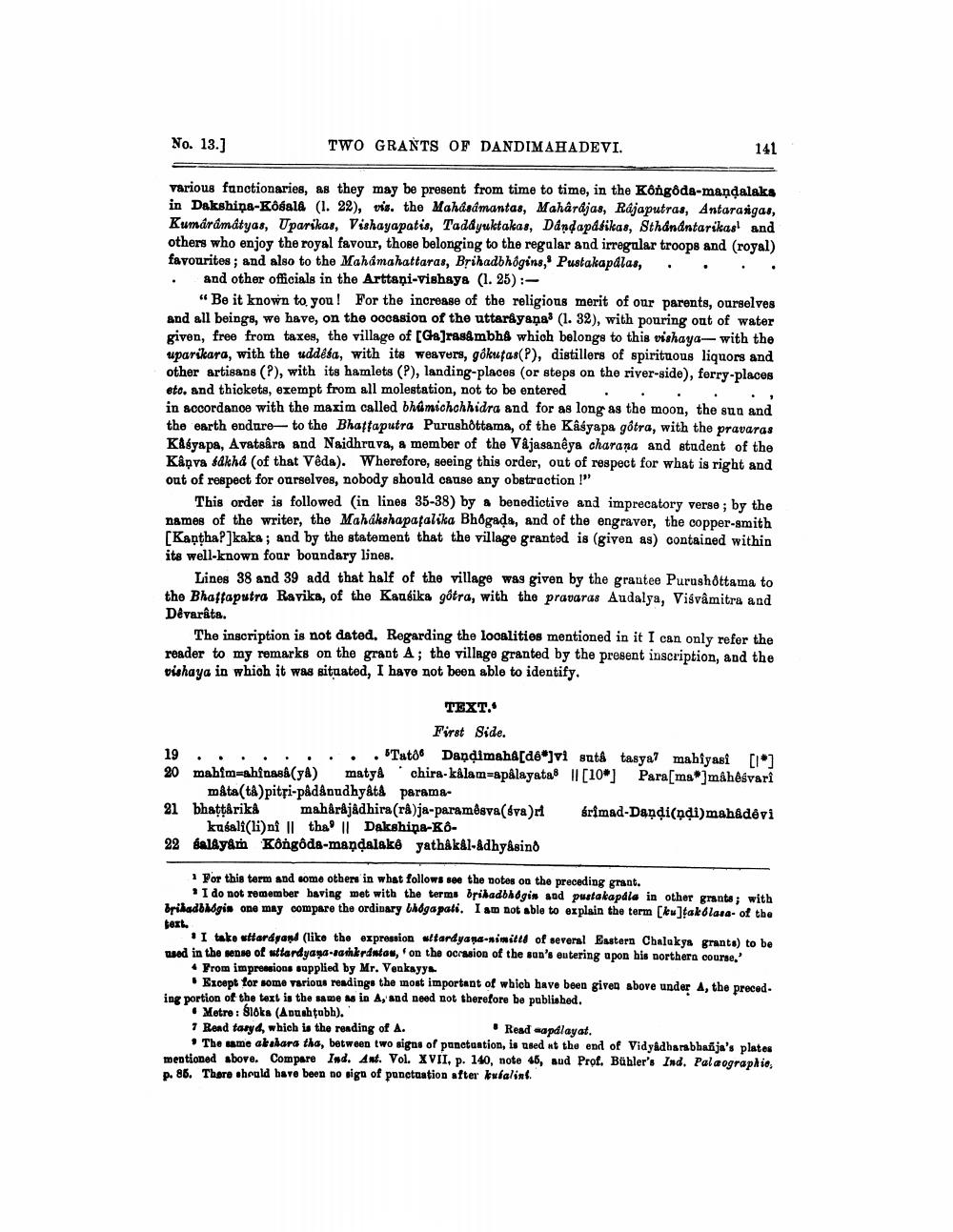________________
No. 13.)
TWO GRANTS OF DANDIMAHADEVI.
141
various functionaries, as they may be present from time to time, in the Kóngôda-mandalaks in Dakshiņa-KobalA (1. 22), vis. the Mahasamantas, Mahârdjas, Rajaputras, Antarasigas, Kumárâmatyas, Uparikas, Vishayapatis, Tadayuktakas, Dandapafikas, Sthanantarikasi and others who enjoy the royal favour, those belonging to the regular and irregular troops and (royal) favourites; and also to the Mahamahattaras, Brihadbhôgins, Pustakapdlas, . . . . and other officials in the Arttaņi-vishayx (1.25):
"Be it known to you! For the increase of the religious merit of our parents, ourselves and all beings, we have, on the oocasion of the uttarayana' (1. 32), with pouring out of water given, free from taxes, the village of [G&]ras&mbhê which belongs to this vishaya- with the uparikara, with the uddésa, with its weavers, gókufas(?), distillers of spirituous liquors and other artisans (?), with its hamlets (P), landing-places (or steps on the river-side), ferry-places eto. and thickets, exempt from all molestation, not to be entered . . . . . , in socordance with the maxim called bhimichchhidra and for as long as the moon, the sun and the earth endare- to the Bhattaputra Purushottama, of the Kasyapa gôtra, with the pravaras KASYAPA, Avatsara and Naidhruva, a member of the V&jasanêya charana and student of the Kinya sakhd (of that Vêda). Wherefore, seeing this order, out of respect for what is right and out of respect for ourselves, nobody should cause any obstraction !
This order is followed (in lines 35-38) by a benedictive and imprecatory verse; by the names of the writer, the Mahákshapatalika Bhôgada, and of the engraver, the copper-smith Kanthap]kaka; and by the statement that the village granted is (given as) contained within its well-known four boundary lines.
Lines 38 and 39 add that half of the village was given by the grantee Purushottama to the Bhaffaputra Ravika, of the Kausika gôtra, with the pravaras Audalya, Visvâmitra and Devarata.
The inscription is not datod. Regarding the localities mentioned in it I can only refer the reader to my remarks on the grant A; the village granted by the present inscription, and the vishaya in which it was situated, I have not been able to identify.
TEXT.
First Side. 19 ..... . Tată6 Dandimaha[de]vi sutá tasya7 mahiyasi 17 20 mahim-shinask(y) maty 'chira-kålam=apalayatas 11[10] Para[ms]mahesvari
m&ta(tá)pitfi-pådanudhy&ta parama21 bhattårika maharajadhira(ra)ja-paramêsva(sva) Srimad-Dandindi)mahadevi
kasali(li)ni || tha || Dakshina-Kô22 salAyam Kôngôda-mandalake yathåkal-Adhyâsind
1 For this term and some others in what follows see the notes on the preceding grant.
* I do not remember having met with the terms bribadbhagin sad pustakapdla in other grants; with brikado Magin one may compare the ordinary Llogapali. I am not able to explain the term [kw]takolare of the text.
I tako stlard yard (like the expression standyana-nimitll of several Eastern Chalakys grants) to be used in the sense of uttardyaya-sankrantas, on the ocasion of the sun's Outering upon his northern course,
From impressions supplied by Mr. Venkayy
• Except for some various reading the most important of which have been given above under A, the preced. ing portion of the text is the same min A,' and need not therefore be published.
• Metre : Bloks (Apushtubh). 7 Rend tacyd, which is the reading of A.
Read aaplayat. • The name akalara tha, between two signs of panetaation, is used at the end of Vidyadharabhaija's plates mentioned above. Compare Ind. An. Vol. XVII, p. 140, note 46, aud Prof. Bühler's Ind. Palaographie p. 86. There should have been no siga of punctuation after kuhalins.




